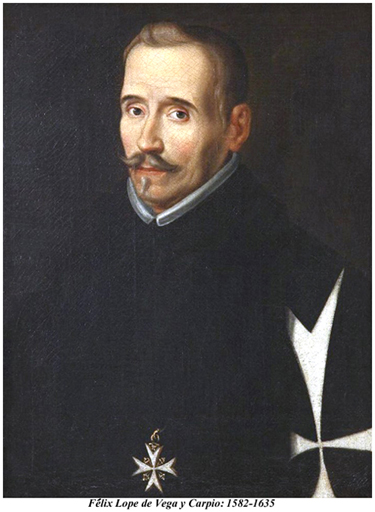
Félix Lope de Vega y Carpio: 1582-1635
Return
| Term | Meaning |
|---|---|
| Autos sacramentales | Liturgical dramas. |
| Bann | Announcement in church of a marriage. |
|
Batin de oficina (palo),
vara de oficina 3 |
Baton of office (staff), rod of office |
| Bollesta 4 | Crossbow. |
|
"Buñolero"
(text used in original play) 5 |
Fritter-maker (work that "Moriscos" did to the exclusion of other peoples in Spain). |
| Carros | "Carros" are "cars" or floats used in religious processions. |
| Comedias |
Typically three-act plays that teach language, customs, values, beliefs.
The audience targeted being illiterate peasants. The structure of these
plays being Aristotelian unities of place, time, and action (not too many
places, not too many times, not too many ideas), else the audience will
become confused, then bored, then hostile (and will start talking and will
leave).
Types of Comedias:
|
Comedia character types or roles:
|
Picturesque aspects of plays. |
| Corrals |
Theatres, composed of a large open area called the patio
where spectators (men called "mosqueteros") stood, set
among three large buildings with an elevated stage. Spectators
could pay a little more to sit on benches ("gradas") behind
the patio. Many theatres had tertulia (cushion-covered
benches in front of the stage) reserved for educated monks and
censors. A separate section of benches called the "casuela"
was cordoned off for female spectators, behind the men. The wealthy
could rent rooms with windows and balconies in the buildings
overlooking the patio. At the highest level of the buildings
surrounding the patio was the desván, reserved for
and rented by the nobility. In the desván, there
was a hidden theatre-box for the king who sat behind a Moorish
screen. Actors were dressed in elaborate costumes. The plays
were mostly in the form of "commedia dell'arte", and
also of the variety known as "jongleuresque" (mimes,
traveling players, clowns, jugglers, troubadores, etc.)
Stages were uniformly of the same size and composed of three levels:
|
| Costumbrista | Picturesque aspects of plays. |
| Entreméses | Comic interludes between acts of long performances, often composed of satires customes and occupations of characters. Farces called "sainete". This kind of theatre evolved into "Zarzuela", c. 1850. Scenery for entreméses often included "trompe l'oeil" and linear-perspective scenery. |
|
Fuenteovejuna,
Fuente Ovejuna, Fuenteovejunaville (p. 92) |
The sheep well (The Sheep well village) |
| Gracioso | A clown or jester (especially in entreméses. |
| Hilanderas 6 | Women that spin thread. |
| Labradore | Farmer, peasant. |
| Maricone 7 | Homosexual (perjorative). |
| Moros 8 | Moors. |
| Pasos | One-act plays. |
| Perro 9 | Dog, mongrel. |
|
"pícaros"
(Spanish slang) 10 |
Thugs, pimps or vagabounds. |
| Refranes | Practical morality (pastoral stories, chivalry, ballads). |
| Rollizo 11 | Plump or fat. |
| Romances | Dreams and ideals. |
| tocas y basquiñas 12 | Headresses and petticoates. |
| Tramoya | Stage machinery. |
| Villano 13 | Bumpkin (literally: villager, peasant). |
| Zarzuela | Light opera, emphasizing music. |
© Copyright 2006 - 2019
The Esther M. Zimmer Lederberg Trust
 Website Terms of Use
Website Terms of Use